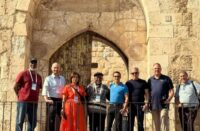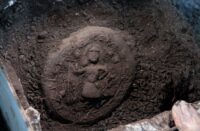
Originally published in Faith Wire
The ancient ruins of a Christian refuge or early church dating as far back as the first centuries of the Roman Empire were recently discovered in Manbij, Syria. The area, which was formerly under ISIS control, managed to escape the attention of the terror group known for destroying churches and other Christian artefacts of the regions they conquer.
ISIS invaded Manbij in 2014. During this time, Abdulwahab Sheko, head of the Exploration Committee at the Ruins Council in Manbij, was studying the area. In an interview with Fox News, Sheko noted that the site was lucky to have escaped the group’s attention. He kept quiet about the ruins until 2016, when ISIS was driven out by the U.S.-backed Syrian Democratic Forces (SDF).
During their two-year occupation of the area, ISIS forces failed to notice the tip of an old gate on an empty mound of land where they dumped garbage. But Sheko explained that the gate, which ran several feet into the ground down, leads straight to the old Christian ruins.
“I was so excited, I can’t describe it. I was holding everything in my hands,” Sheko said of the discovery.
Several crosses etched into columns and walls, and writings carved into stone indicate that the underground ruin was a special place where persecuted Christians under the Roman Empire congregated.
“This place is so special. Here is where I think the security guard would stand at the gate watching for any movement outside,” Sheko explained as he led reporters through the “first location” of the site. “He could warn the others to exit through the other passage if they needed to flee.”
American archaeologist John Wineland told Fox that the discovery of this “secret church” could be crucial to understanding the lives of Christians under Roman rule.
“They indicate that there was a significant Christian population in the area which felt they needed to hide their activities,” said Wineland, who is a professor of history and archaeology at South-eastern University. “This is probably an indication of the persecution by the Roman government, which was common in the period.”
Sheko explained that due to the area being riddled with dangerous mines and booby traps, excavation of the site couldn’t begin until late August last year. By March, however, Sheko and his team had uncovered enough artefacts to host “a festival” for locals to come and see the long-hidden treasure.
A recently discovered “second location” — which is still full of insects, trash and even a stray dog who made his home there — harbours an underground cave with “a multitude of rooms” containing “overt Christian symbols” that are “etched into the stone walls and across the arched ceilings.”
Sheko noted that it is believed this second location was added following a more widespread acceptance of Christianity in the region.
“We think this place after Christianity was no longer a secret anymore,” he explained, pointing to the symbols.
Wineland agreed, telling Fox that based on the photographs he’s seen, “the crosses chiselled into the walls, along with geometric designs consistent with the Roman era, appear to have been added later, after wider acceptance of the Christian faith.”
The subterranean ruins also contain a “graveyard,” which Sheko explained was likely reserved for the church clergy. Each tomb contains an elevated “stone cushion” for the deceased’s head.
Sheko added that there are many more potential ruins that have yet to be uncovered, but residential buildings located above them make the excavation process complicated.
The city of Manbij is located in north eastern Aleppo Governorate, near the Turkish border. It was once considered one of Syria’s most ancient and prized townships, according to Fox. Archaeologists believe many more Christian sites could be unearthed as ISIS loses ground in these areas.
“This has led to a significant decline of Christians in the region. Some have been killed, others have fled, and still others have been coerced into converting to Islam,” he said.
Sheko, who is Muslim, hopes his efforts to preserve the incredible historical relics will help to distinguish himself and others from the incredibly hostile ISIS Muslims.
“We are Muslim, but we are not like ISIS Muslims,” he said. “We take care of these Christian ruins. We respect them. We respect humanity.”






